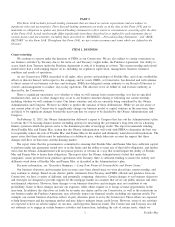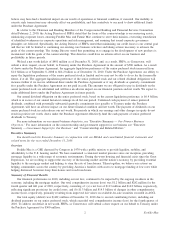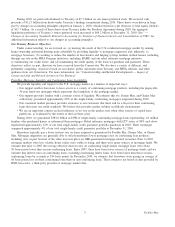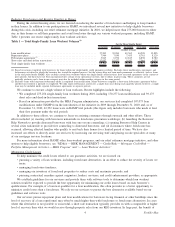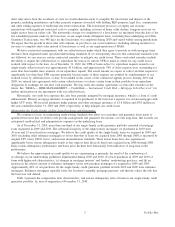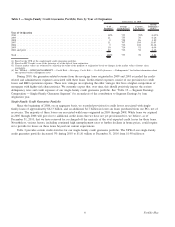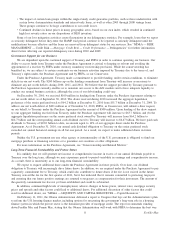Freddie Mac 2010 Annual Report Download - page 14
Download and view the complete annual report
Please find page 14 of the 2010 Freddie Mac annual report below. You can navigate through the pages in the report by either clicking on the pages listed below, or by using the keyword search tool below to find specific information within the annual report.
place for any such loan, provided that the current LTV ratio of the loan at the time of refinance does not exceed 125%. The
relief refinance mortgage initiative is our implementation of this refinance program.
We also focus on maintaining underwriting standards that allow us to purchase and guarantee loans made to qualified
borrowers that we believe will provide management and guarantee fee income, over the long-term, that exceeds our
anticipated credit-related and administrative expenses on the underlying loans.
Our Business Segments
Our operations consist of three reportable segments, which are based on the type of business activities each performs —
Single-family Guarantee, Investments, and Multifamily. Certain activities that are not part of a reportable segment are
included in the All Other category.
We evaluate segment performance and allocate resources based on a Segment Earnings approach. Beginning January 1,
2010, we revised our method for presenting Segment Earnings to reflect changes in how management measures and assesses
the financial performance of each segment and the company as a whole. For more information on our segments, including
financial information, see “MD&A — CONSOLIDATED RESULTS OF OPERATIONS — Segment Earnings” and
“NOTE 17: SEGMENT REPORTING.”
Single-Family Guarantee Segment
The Single-family Guarantee segment reflects results from our single-family credit guarantee activities. In our Single-
family Guarantee segment, we purchase single-family mortgage loans originated by our seller/servicers in the primary
mortgage market. In most instances, we use the mortgage securitization process to package the purchased mortgage loans
into guaranteed mortgage-related securities. We guarantee the payment of principal and interest on the mortgage-related
security in exchange for management and guarantee fees.
Our Customers
Our customers are predominantly lenders in the primary mortgage market that originate mortgages for homeowners.
These lenders include mortgage banking companies, commercial banks, savings banks, community banks, credit unions,
HFAs, and savings and loan associations.
We acquire a significant portion of our mortgages from several large lenders. These lenders are among the largest
mortgage loan originators in the U.S. Due to the mortgage and financial market crisis during 2008 and 2009, a number of
larger mortgage originators failed or were acquired and, as a result, mortgage origination volume during 2010 was
concentrated in a smaller number of institutions. See “RISK FACTORS — Competitive and Market Risks” for further
information. During 2010, three mortgage lenders (Wells Fargo Bank, N.A., Bank of America, N.A. and Chase Home
Finance LLC) each accounted for more than 10% of our single-family mortgage purchase volume and collectively accounted
for approximately 50% of our single-family mortgage purchase volume. Our top ten lenders accounted for approximately
78% of our single-family mortgage purchase volume during 2010.
Our Competition
Historically, our principal competitors have been Fannie Mae, Ginnie Mae and FHA, and other financial institutions that
retain or securitize mortgages, such as commercial and investment banks, dealers, and thrift institutions. Since 2008, most of
our competitors, other than Fannie Mae and Ginnie Mae, have ceased their activities in the residential mortgage
securitization business or severely curtailed these activities relative to their previous levels. We compete on the basis of price,
products, the structure of our securities, and service.
Ginnie Mae, which has become a more significant competitor since 2008, guarantees the timely payment of principal
and interest on mortgage-related securities backed by federally insured or guaranteed loans, primarily those insured by FHA
or guaranteed by VA. Ginnie Mae increased its share of the securitization market in 2010, in large part due to favorable
pricing of loans insured by FHA, the increase in the FHA loan limit and the availability, through FHA, of a mortgage
product for borrowers seeking greater than 80% financing who could not otherwise qualify for a conventional mortgage.
The conservatorship, including direction provided to us by our Conservator, and the restrictions on our activities under
the Purchase Agreement may affect our ability to compete in the business of securitizing mortgages. On a number of
occasions, FHFA has directed us and Fannie Mae to confer and consider uniform approaches to particular issues and
problems, and FHFA has in a few cases directed the two GSEs to adopt common approaches. For example, in January 2011,
FHFA announced that it has directed Freddie Mac and Fannie Mae to work on a joint initiative, in coordination with HUD,
to consider alternatives for future mortgage servicing structures and servicing compensation, including the possibility of
reducing or eliminating the minimum servicing fee for performing loans, or other structures. FHFA has also directed Freddie
Mac and Fannie Mae to discuss with FHFA and with each other, and wherever feasible to develop consistent requirements,
policies and processes for, the servicing of non-performing mortgages, and to discuss joint standards for the evaluation of the
servicing performance of servicers. It is possible that FHFA could require us and Fannie Mae to take a common approach
11 Freddie Mac


